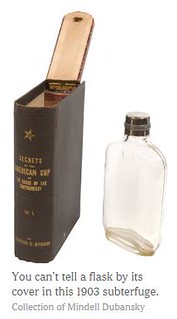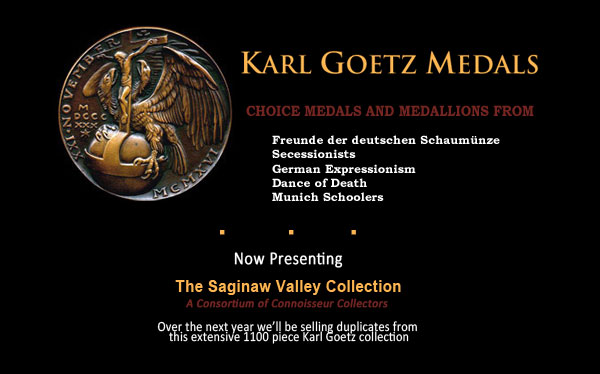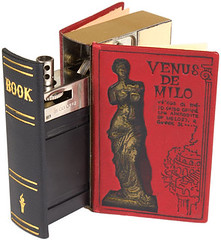
PREV ARTICLE
NEXT ARTICLE
FULL ISSUE
PREV FULL ISSUE
BLOOKS: THE ART OF BOOKS THAT AREN’T
For bibliophiles and anyone with a sense of whimsy, Pablo Hoffman forwarded this New York Times article on a Grolier Club exhibit
of fake books. Yes - books that aren’t real books, just look like they are. -Editor
“An electric charge of grief went through my entire body,” Ms. Dubansky, the longtime preservation librarian at the Metropolitan Museum of Art, recalled. A light bulb also went off in her head. Sensing an unexplored territory, Ms. Dubansky set out to map the contours of the world of fake books, eventually amassing about 600 made from stone, wax, straw, wood, soap, plastic, glass and other materials. She even coined a term for them: “blooks,” short for “book-look.” Some 200 items from her collection went on display on Thursday at the Grolier Club in Manhattan, a temple to books, where they will remain through March 12. The exhibition, “Blooks: The Art of Books That Aren’t,” appears to be the first of its kind in the United States.  
Most exhibitions at the Grolier, whose grand library holds more than 100,000 volumes with real pages and sometimes spectacular fine bindings, don’t include items like Secret Sam’s Spy Dictionary, a 1960s toy that lets users photograph enemies with a camera hidden inside a fake tome that also shoots plastic bullets out of its spine. To Ms. Dubanksy, the larger goal of the show is to have fake books accepted as a real part of biblio-history. “I see blooks as a parallel to book history, but I’ve had trouble getting people to take them seriously because of the association with kitsch,” she said. While it can be hard to establish a clear history of blooks, they may have existed as long as the codex itself. There were elaborate medieval reliquaries shaped like books, as well as items like a book-shaped beer keg Ms. Dubansky saw described in an old text. The Grolier show ranges chronologically from an 18th-century wooden volume that opens up into an altar (apparently used by Roman Catholics, Ms. Dubansky said) to a purple plastic children’s toy from the mid-1990s called a Polly Pocket. The objects in categories — religion, commemoration, photography, food, toys, grooming and so on — forming what Ms. Dubansky calls a tentative taxonomy of blooks. It’s hard not to be charmed by the emotional intensity, inventiveness and sometimes sheer whimsy of the items in the chockablock display cases. In one, book-shaped boxes for office supplies sit near a delicate straw-work sewing kit, made by a French prisoner during the Napoleonic Wars. A display of mini-blooks includes a pocket clothes brush tucked inside a volume by “Y. B. Untidy.” A case dedicated to food includes book-shaped containers and promotional displays for biscuits, coffee and sardines. (Sardines?) Among the hardest sub-collections to assemble, Ms. Dubansky said, was a case of corny gag books. These include a 1941 anti-baldness volume called “How to Save Your Hair” (inside: a plastic bag in which to place the strands that had fallen out) and several “exploding books” made by the novelty company S. S. Adams, better known for the whoopee cushion and joy buzzer. “It took me years just to make this collection,” she said. “In their time they were very popular, but they were disposable.”
In the fake numismatic books department, I have a green cloth-covered volume in my library about the size of a Redbook. In gilt the cover
reads, "TALES OF THE GREATEST COIN ROBBERIES BY AGON IFF". Inside, it's a 1963 Redbook. A penciled note inside says
"From Ray Byrne." I didn't know what "AGON IFF" was, but I've been around the block enough times to guess
when that happens, somebody's being cute and using Yiddish. Sure enough, a gonif (or goniff) is "a thief or dishonest person or
scoundrel." I'm not sure anymore where I got this item, but it may have been from Ray's fellow Pittsburgher Glenn Mooney.
The penciled date looks like 2-16-74. -Editor
To read the complete article, see:

Wayne Homren, Editor The Numismatic Bibliomania Society is a non-profit organization promoting numismatic literature. See our web site at coinbooks.org. To submit items for publication in The E-Sylum, write to the Editor at this address: whomren@gmail.com To subscribe go to: https://my.binhost.com/lists/listinfo/esylum All Rights Reserved. NBS Home Page Contact the NBS webmaster 
|
